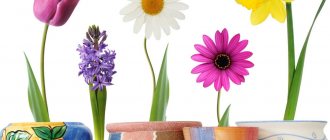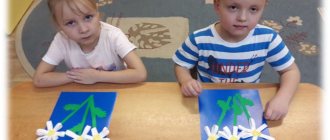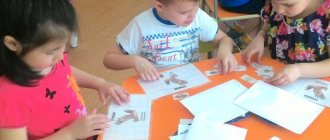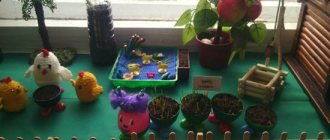Project for children of the preparatory group “Houseplants are our friends”
Elena Astrakhantseva
Project for children of the preparatory group “Houseplants are our friends”
Project for children of the preparatory group
«Houseplants are our friends»
.
Type of project : research, cognitive-creative, short-term (weekly, group .
Project participants : teachers and children of the preparatory group .
Educational areas: communicative, productive and cognitive activities.
Relevance
“To live you need sun, freedom and a little flower”
.
G. – H. Andersen.
Since ancient times, man has sought to decorate his home with plants . Interior landscaping arose as an element of human culture that meets his aesthetic needs. Man felt himself to be one with nature; he turned to it for healing, bringing a piece of living nature into his home. This desire was intuitive. Currently, a scientific approach to interior gardening involves combining the aesthetic perception of the beauty of the form, color of flowers and leaves of plants with another useful function of plants , which has long been known: living plants improve the composition of the air and purify the atmosphere.
Preschoolers spend most of the year in kindergarten, so it is necessary to decorate it with evergreens , which play not only an aesthetic and educational role, but also an educational one. Usually, in any kindergarten, in the corners of nature, there are many different plants brought, depending on their tastes and preferences, by teachers and children, and even parents. Indoor plants create a more comfortable environment, but there is another very important side to their presence - living plants have a beneficial and sometimes even healing effect on our well-being.
Indoor plants bring variety and harmony into our lives. By caring for them, a person is distracted from the bustle of the city, family problems, troubles in everyday life and at work. By observing indoor plants , we learn and grow with them , and we simply relax our souls.
This project involves research work, performing creative and practical tasks, and is aimed at deepening knowledge about indoor plants .
Project “ Indoor plants are our friends ”
children's theoretical knowledge with practical skills acquired during research, develop interest in the world around them and ultimately please their mother with a gift - a flower grown with their own hands.
Goal: to develop interest in the development and growth of indoor plants , observation and curiosity, visual and effective thinking.
Tasks:
1. Contribute to expanding children’s knowledge about indoor plants and their significance in human life.
2. Continue to familiarize children with the structure of the plant , the features and purpose of its parts.
3. Develop practical skills in caring for indoor plants .
4. Develop cognitive interest and research skills (ability to compare, analyze, draw conclusions)
.
5. Expand the ecological environment of the group , unite the efforts of the teacher, children and parents aimed at improving and greening the group .
6. Expand and activate the vocabulary of preschoolers.
children's creative abilities .
8. Develop the mental processes of preschoolers (attention, memory, thinking, imagination)
.
9. Cultivate a caring attitude and love for plants , instill an interest in floriculture.
Expected results:
1. Expanding knowledge on the ecological culture of pupils.
2. Development in children of a sustainable interest in representatives of the plant world - indoor flowers .
3. Development of research activities of preschoolers in the course of joint practical activities with the teacher.
4. Enrichment of children’s vocabulary on this topic
Project implementation :
1. Conversations ( “Useful tips”
,
“
Indoor plants in the interior ” ,
“Getting to know
indoor plants ” ,
“What
indoor plants live in your home ?” ,
“What I remember and liked most”
).
2. Direct educational activities (Cognition. Formation of a holistic picture of the world, broadening one’s horizons: “Journey to the kingdom of indoor plants ”
, Ecology
"
Indoor plants " , Communication
"Flowering
indoor plants " , Communication
"
Indoor plants " , Communication.
Lesson on a series of plot pictures “The Scarlet Flower”
.
3. Reading fiction (Andersen Hans Christian “Thumbelina”
,
“Picky”
Russian folk tale, poems by E. Blaginin
“Balzamin”
, G. Rakov
“Violet”
,
“Aspidistra”
,
“Ficus”
,
“Begonia”
, etc., L. Pilipenko
“Asparagus”
,
“Kalanchoe”
,
“ Aloe”
,
“Saxifrage”
, etc., V. Tushnova
“I don’t understand”
, S. Karatov
“
Indoor flowers ” , N. Nishcheva
“
Indoor flowers ” , O. Alenkina
“Cactus”
, I. Evdokimova
“Cactus”
, Yu. Lysakov
“Cactus”
, B. Ferper
“Begonia”
, B. Pasternak
“Geranium”
, etc.
4. Work in the book corner (subject pictures on the topic, paintings from the series “Care for indoor plants ”
, paintings from the album on speech development
“Children Watering Flowers”
).
5. Search and cognitive activity. (excursion of parents with children to shops - flower department)
6. Experimental activities (studying the structure of a plant leaf under a microscope , cyclic observations: Houseplants decorate our home , Do we need to water the plant ? What kind of water do plants ? Spraying plants , For flowering plants , Examining a new plant , What has changed)
7. Productive activity ( “My favorite flower”
(drawing,
“Geranium”
(applique,
“Calla” (hand labor, from cotton pads and cotton swabs)
.
8. Ecological games ( “If you were an indoor flower ”
).
9. Didactic games ( “Find out the plant ”
,
a plant
by description ” ,
“Where
flowers grow ” ,
“Find the same one”
,
“Find what I’ll tell you about”
,
“Big and small”
,
“Find
a plant ” ,
“Guess what kind of
plant ” ,
“Florist”
,
“Find out
the plant ” ,
“Guess
the plant by description ” ,
“Describe it, and we’ll guess”
,
“Go shopping”
,
“Who needs what”
,
“What’s extra”
,
grows
and how ” ,
“Find
a plant by name ” ,
“Describe the flower”
,
“Riddle, we will guess”
,
“Collect the flower”
,
“What has changed?”
,
“Sell what I name”
,
“Find out
the plant ” ,
“The fourth odd one”
,
“Let’s decorate
the room ” ,
“Collect a bouquet”
,
“Which flower is missing?”
,
“Where is
the plant ?” ).
10. Finger games ( “ Our scarlet flowers ”
,
“There is a prickly flower on the window”
,
“Flower”
).
11. Moving, round dancing games ( “Flowers and the Wind”
,
“
Plants ” ,
“Who can plant flowers faster”
,
“Galya was walking around the garden”
).
12.Board games: “Lay out the flowers”
(mosaic,
“Assemble
a houseplant ” ,
“Assemble a bouquet”
,
“Flower Lotto”
, Domino -
“Flowers”
.
13. Physical education minutes.
14. Morning exercises.
15. Labor activity (watering indoor plants , washing indoor plants , caring for indoor plants : fertilizing, loosening, planting flower seedlings, cutting indoor plants , replanting indoor plants , observing indoor plants in a group , comparing indoor plants .
16. Independent play activities of children . (looking at books, illustrations, albums, postcards with indoor plants , coloring flowers in coloring books, productive activities,
17. Music. P. Tchaikovsky “Waltz of the Flowers”
, excerpt from Concerto for cello e-moll by F. Mendelssohn, musical excerpt from
“Romeo and Juliet”
by S. S. Prokofiev, musical excerpt from Humoresque by A. Dvorak.
18. Watching the cartoon: “Thumbelina”
19.Presentation: “ Indoor plants ”
.
Assessment of the quality of project .
Project “ Indoor plants are our friends ”
involves work with
preparatory group , parents and teachers and is designed for one week.
Analysis of activities will be monitored at the end of the project using observations, interviews with children, teachers and parents. The project implemented through different types of children's activities.
Parents are active helpers in working on the project .
According to parents and teachers, the project “ Indoor plants are our friends ”
interesting and relevant. Thus, we expand the environmental knowledge of preschoolers, form norms of behavior in the natural environment and adherence to them in everyday life, display an active attitude towards natural objects and children acquire practical skills.
Prognostic results.
Children, parents and teachers will have the opportunity to expand knowledge about indoor plants , their significance in human life, develop practical skills in caring for indoor plants and expand the ecological environment of the group .
Dissemination of experience in this area.
The developmental environment in the group .
The relationship between kindergarten and family.
Project work “Indoor plants in our lives”
Slide 1
Municipal budgetary educational institution "Secondary school No. 77" of the Aircraft Construction District of Kazan Project Houseplants in our lives Completed by: A. Klimovskikh, student of 1st A class. head: Kuzova L.A. primary school teacher
Slide 2
Introduction Houseplants constantly accompany us at home and at school. They please the eye with their appearance and improve indoor air. I decided to learn more about our green friends, so I chose “Houseplants in our lives” as the topic for my project work.
Slide 3
A little history People started growing flowers in their homes in ancient times. There are images of plants in pots on ancient frescoes. First of all, they began to engage in this business in those countries where there was a favorable climate without sharp temperature fluctuations and a large number of different plant species (for example, China). Floriculture came later to countries where winter occurs. In Europe, the first winter garden was created in the 13th century by the eminent gardener Albertus Magnus. The creator was accused of witchcraft because the garden turned out amazing. The rulers of all countries wanted to have such a miracle, so home floriculture began to develop rapidly. In Russia, the beginning of breeding indoor plants is usually associated with the name of Peter I, when all sorts of foreign wonders began to actively appear in our country. Heroes of the fairy tale by G.Kh. Andersen's "The Snow Queen" (1844) Kai and Gerda were also engaged in home floriculture
Slide 4
Types of indoor plants Decorative foliage Flower growers value and grow them for their unusual leaves, which can be of different shapes and colors. These plants bloom with small and non-decorative flowers. Decorative flowering plants These plants delight people with their flowers. They can bloom at different times of the year, and some throughout the year. There are representatives of the group that form berries and fruits. Bromeliads Bromeliads are star-shaped rosettes of tough, often spiny leaves. Numerous inconspicuous flowers are formed at the bottom of the rosette recess. During flowering, areas of the leaves turn bright colors, which decorates the plant.
Slide 5
Types of indoor plants Cacti and succulents These plants are able to store moisture in their organs. They are very resistant and unpretentious, compact in size and bloom decoratively with a mysterious flowering time, mainly at night. Ferns These are plants with graceful, beautiful leaves. They never bloom because they reproduce by spores that form in special boxes on the underside of the leaves. Bulbous They grow from underground bulbs. They bloom very beautifully, but fade quickly. Palms Large plants with decorative leaves that come in two forms: pinnate (the leaf resembles a bird's feather) and fanfolia (the leaf resembles a fan).
Slide 6
Arrangement of indoor plants
Slide 7
Indoor plants and people - mutually beneficial cooperation Improve the climate in the room; Filters out dust particles in the air; Cools the air in summer due to evaporation; Increase air humidity; They release oxygen and absorb carbon dioxide; Helps relieve stress and improve well-being; Make the room more comfortable; They are indicators of the microclimate in the house. Provide habitat; Create favorable conditions for growth and development; Provide timely care.
Slide 8
Factors influencing indoor plants. What can we do to make our green friends have a GOOD life? Illumination Study how demanding the plant is for light and place it correctly; In winter, use special lighting for light-loving plants. Humidity Study the plant’s requirements for moisture; Water and spray plants with a spray bottle in a timely manner; Some plants benefit from a warm shower; Wipe the leaves with a soft damp cloth to remove dust so that the plant can absorb moisture from the air. Temperature Maintain the air temperature in the room required for the plant; In winter, under flowers standing on a cool windowsill, you can place a special stand that will protect the roots from hypothermia. Soil quality and pot size Find out what kind of soil and pot the plant needs and choose them correctly; Use drainage to improve the flow of air to the roots and the drainage of excess moisture; Loosen the soil in the pot; Promptly replant plants that become cramped in their pots. Diseases and pests See and recognize the threat in a timely manner; Quickly take the right measures to eliminate it.
Slide 9
It is important! Plants are living organisms, with their own “character” and characteristics. Before you “invite” a plant into your home, you need to find out what conditions are necessary for its growth and development. This also applies to caring for our green friends. There is only one thing you can do without prior preparation - love your houseplants. They will respond to you with rapid growth and flowering if you sometimes talk to them, share your experiences with them, and touch their leaves with love and tenderness. By loving and properly caring for plants, you can surround yourself with “happy” indoor flowers that will please the eye and will be able to do what they do well.
Slide 10
My roommates are Chlorophytum and Nephrolepis
Slide 11
Chlorophytum is a very unpretentious indoor plant, which is a perennial (up to 10 years of life) herbaceous bush with narrow leaves and hanging airy tendrils, on which small flowers and bushes of new young plants are located. Chlorophytum can grow in any soil, in a pot of any size, in a cool or warm room, in the sun or shade. It can go without water for a long time because it accumulates it in its roots. Chlorophytum is a good neighbor: it decorates my room, purifies the air in it from harmful impurities, and releases a lot of oxygen. In order for my green friend to feel good, I water it as the soil dries out; To wash away the dust from the leaves, sometimes I give him a warm shower. From spring to autumn we feed it with mineral fertilizers once a month. As soon as my neighbor runs out of space in his pot (the roots come out of the pot), we will transplant him into a larger pot in the spring.
Slide 12
Nephrolepis is an indoor fern. In addition to its attractive appearance, this plant also attracts attention because it perfectly purifies the air (it easily absorbs formaldehyde and toluene). Besides, this neighbor of mine kills germs. There is even a belief that ferns create a calm atmosphere, help to absorb new knowledge and help memorize necessary information. That's why my mother and I put Nephrolepis in my room. This green friend of mine is more demanding of care than chlorophytum: It loves light, but I protect it from bright sunlight, which causes burns in nephrolepis; Requires high humidity. I water it daily, pouring water into a tray under the pot so that it absorbs it gradually. I spray the leaves with a spray bottle in the morning or evening. 3. The roots of nephrolepis are shallow, so we chose a shallow, wide pot for it and poured more drainage into it to allow air to enter. We chose light and loose soil and fertilize it once a week.
Slide 13
Literature: www.flowersweb.info www.greendom.net www.cvetochki.net www.flovertimes.ru Dr. D.G. Hessayon “All about indoor plants”, Kladez-Buks, Moscow, 1999.
Goals and objectives of the project.
The purpose of this project:
Creating a favorable climate in classrooms to preserve and improve the health of students.
Tasks:
Educational:
- teach to recognize indoor plants; look after them; familiarize yourself with the rules for arranging indoor plants.
Educational:
- to form social activity and tolerance.
Educational:
- develop aesthetic perception in interior design; improve artistic taste. develop cognitive interest among students by involving them in search and project creative work.








